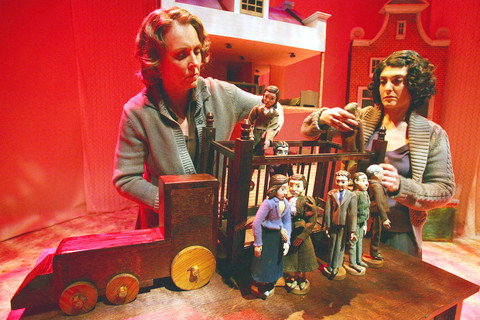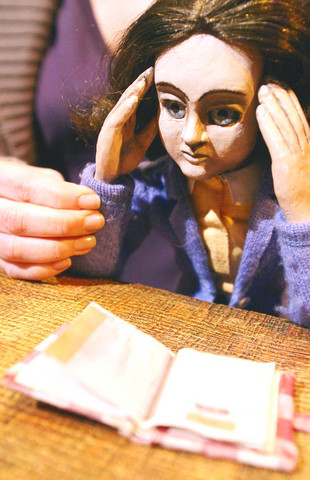The idea of turning Anne Frank's diary into a puppet show for adults sounds at first blush like someone's idea of a bad joke.
After all, her story is a classic. Her diary has sold more than 30 million copies in 50 languages, making it the most popular secular book in history. The warren of secret rooms in Amsterdam where the Frank family and four others hid from the Nazis from 1942 to 1944 is one of the most frequently visited places in the world. (Last year it had almost 1 million visitors.) A 1955 play based on the diary has been endlessly produced, challenged and updated.
But Bobby Box, the creator of Anne Frank: Within & Without believed that puppets could bring new depth and perspective to the wartime memoir. Theatergoers apparently agree. Box's new version, which opened last week at the Center for Puppetry has been playing to sold-out crowds. The show has been so successful that the center is considering touring the production.

PHOTO: NY TIMES NEWS SERVICE
"Puppetry has had a bad rap," said Jon Ludwig, associate artistic director of the center, which has collaborated with the Muppets' creator Jim Henson and with Julie Taymor, who directed The Lion King on Broadway. "We always think it's only for children and that it's like watching a bad birthday party clown. And you think, `How are they going to do something serious like Anne Frank or Shakespeare with puppets?"'
But puppets have long been used to tell serious stories. When the Puritans controlled England in 1642, they locked playhouses to prevent the spread of subversive material. For the next 18 years, the only theater in England was a traveling puppet show in which the workaday everyman Punch took swings with a wooden club at Mother England's stand-in, Judy.
More recently, puppets have found a political voice in productions like the acidly satirical movie Team America: World Police and the ribald Tony Award-winning musical Avenue Q. But part of the success of these works was their tongue-in-cheek execution. A story with a backdrop like the Holocaust could scarcely be approached so lightly.

PHOTO: NY TIMES NEWS SERVICE
Box tackles his subject by having two actresses manipulate the doll-like puppets, which look like pose-able mannequins. The actresses, pin-curled and identically costumed in prim knee-length gray wool skirts, white blouses, gray cardigans and Mary Janes, are both introduced to the audience as Anne. Sometimes they seem to be personifications of Anne's memory or different aspects of her personality. Sometimes they seem like ghostly grown-up versions of an Anne Frank who has been allowed, in death, to age and return to tell her story.
The two performers move the puppets in and around a giant cutaway dollhouse, an exact replica of the annex rooms where Anne and her family hid. Watching grown women play with dolls this way turns out to be surpri-singly macabre.
There are examples of the tender-turned-terrible throughout the show, including a cradle that later becomes the cattle car carrying the residents of the annex to their deaths.
It was Box's intention, he said, to take "the feelings that we have toward certain objects and plug those objects into a place where they're not supposed to go and see what happens."
The somber mood is also created by several impressionistic moments, particularly dream sequences in which Anne puppets (of different sizes) ice-skate or are rocked to sleep in the branches of a chestnut tree.
After a recent performance, a few audience members walked out of the theater dabbing their eyes.
Rita Klein, 63, of Atlanta, who came to see the show with her husband, a Holocaust survivor, pulled out the Kleenex early on. "It was very, very moving and very disturbing," she said.
Andre Kessler, 65, who was also cloistered in an apartment as a child hiding from the Nazis, said he thought it was an inventive way to revisit Anne Frank's story.
As Ludwig sees it, the production succeeds because puppets, by their very woodenness, force the audience to fill in movements, expressions and interior lives.
"When it's a puppet, you're really invoking that spirit," he said. "You're supplying half the work. You're going within. I feel like it's very powerful."

Taiwan Power Co (Taipower, 台電) and the New Taipei City Government in May last year agreed to allow the activation of a spent fuel storage facility for the Jinshan Nuclear Power Plant in Shihmen District (石門). The deal ended eleven years of legal wrangling. According to the Taipower announcement, the city government engaged in repeated delays, failing to approve water and soil conservation plans. Taipower said at the time that plans for another dry storage facility for the Guosheng Nuclear Power Plant in New Taipei City’s Wanli District (萬里) remained stuck in legal limbo. Later that year an agreement was reached

What does the Taiwan People’s Party (TPP) in the Huang Kuo-chang (黃國昌) era stand for? What sets it apart from their allies, the Chinese Nationalist Party (KMT)? With some shifts in tone and emphasis, the KMT’s stances have not changed significantly since the late 2000s and the era of former president Ma Ying-jeou (馬英九). The Democratic Progressive Party’s (DPP) current platform formed in the mid-2010s under the guidance of Tsai Ing-wen (蔡英文), and current President William Lai (賴清德) campaigned on continuity. Though their ideological stances may be a bit stale, they have the advantage of being broadly understood by the voters.

In a high-rise office building in Taipei’s government district, the primary agency for maintaining links to Thailand’s 108 Yunnan villages — which are home to a population of around 200,000 descendants of the Chinese Nationalist Party (KMT) armies stranded in Thailand following the Chinese Civil War — is the Overseas Community Affairs Council (OCAC). Established in China in 1926, the OCAC was born of a mandate to support Chinese education, culture and economic development in far flung Chinese diaspora communities, which, especially in southeast Asia, had underwritten the military insurgencies against the Qing Dynasty that led to the founding of

Artifacts found at archeological sites in France and Spain along the Bay of Biscay shoreline show that humans have been crafting tools from whale bones since more than 20,000 years ago, illustrating anew the resourcefulness of prehistoric people. The tools, primarily hunting implements such as projectile points, were fashioned from the bones of at least five species of large whales, the researchers said. Bones from sperm whales were the most abundant, followed by fin whales, gray whales, right or bowhead whales — two species indistinguishable with the analytical method used in the study — and blue whales. With seafaring capabilities by humans